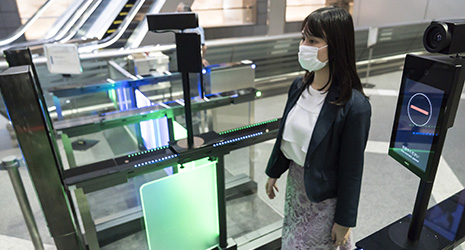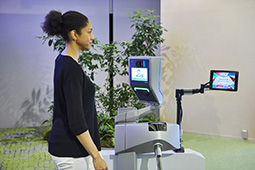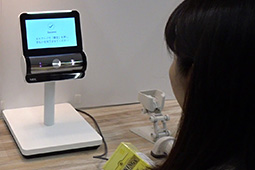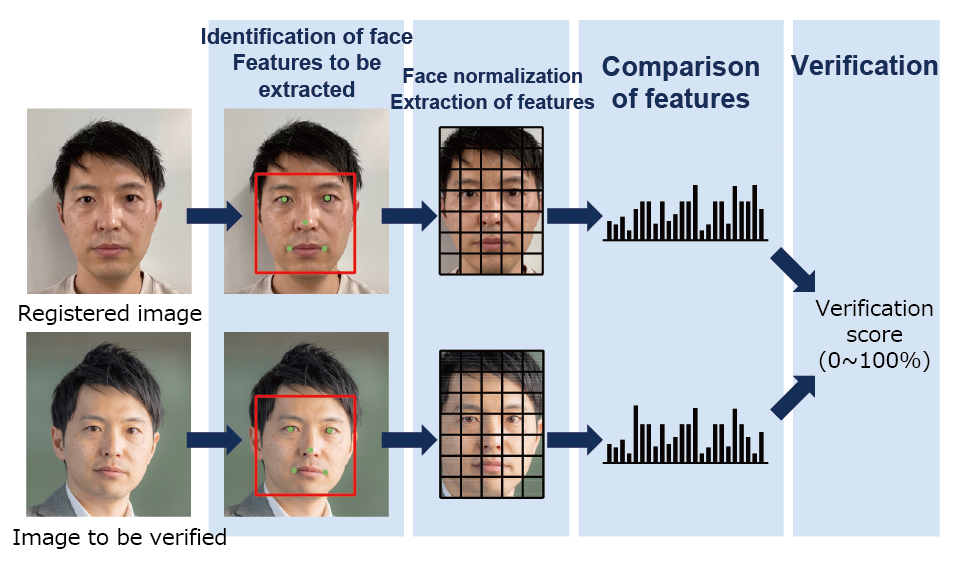September 2022
Advancing Face Recognition

The gated entrance at the NEC headquarters in Tokyo, where access is monitored through face recognition -

Face recognition is possible even when wearing a mask

A woman passes through a gate with a face recognition system installed at NEC Future Creation Hub 
Testing the self-checkout function on a multimodal biometric authentication device

Highly precise face recognition technology developed by a Japanese company is spreading within Japan and abroad.

Following the development of an information-driven society, there are more and more instances of device-based identity verification in everyday life. Among the types of identity verification, biometric authentication, based on physical and behavioral features, has increased in recent years in place of “password recognition,” where users enter a PIN or password, and “object recognition,” where users use a key, card, or certificate.
Takashima Shinya of the Biometrics and Video Analytics Platform Division, Digital Business Platform Unit, NEC Corporation (or NEC), says that “currently, in addition to biometric authentication using physical features, such as fingerprints, face, the iris* or veins in the palm, there are also methods that focus on behavioral features, such as handwriting and the way a person walks. For face recognition, which we have worked to develop over many years, there is no need to touch the machine or hold up your hand. There is the advantage of conducting highly precise verification in a short time, for example, when walking through the gated entrances of buildings.”
NEC began researching fingerprint recognition about half a century ago in 1971, and the company has continued its research and development of face recognition for over thirty years since 1989. To explain the mechanism simply, a face is identified from a verification image taken with a camera, and various features are extracted from the face, including the position of the eyes, nose, and mouth, as well as the contours and tilt of the face. These features are then compared and cross-checked with a registered image prepared beforehand to determine whether it is the same person or not.

In a benchmark test carried out by The US Commerce Department’s National Institute of Standards and Technology (NIST) in 2019**, NEC’s face recognition had a recognition error rate of 0.4% with a 1.6 million person database and achieved a retrieval speed of 230 million faces/second, making it the best in the world. This advanced technology was utilized in practice at the Olympic and Paralympic Games Tokyo 2020, held from July to September 2021. The access management system implemented for the more than forty venues, athlete villages, media centers, and more had a 99.8% precision rate and greatly contributed to the safe and smooth operations of the Games by verifying the identities of a total of 4 million people.
While the wearing of masks has increased in recent years due to COVID-19, NEC’s face recognition can verify a person’s identity from the area around the eyes and other parts of the face with the same precision as it can when a person is not wearing a mask. NEC’s system has been introduced in more than seventy countries and regions worldwide due to its high reliability and was awarded the Commendation for Science and Technology by the Minister of Education, Culture, Sports, Science, and Technology, Government of Japan, in April 2022.
Kikuchi Masaya of the Biometrics and Video Analytics Platform Division, Digital Business Platform Unit, NEC, says, “We can further improve the convenience of the face recognition system by linking it with various information. For example, when an adult enters a restaurant, if we can simply verify their identity, then it becomes no longer necessary to confirm their age when serving alcohol.”

On top of that, the multimodal biometric authentication that NEC has developed allows for extremely accurate recognition, with an error rate of 1 in 10 billion, through the combination of three separate biometric authentication processes for the face and both irises. This method of recognition is considered perfect for situations requiring stringent identification, such as financial purchases, at medical centers, and in the management of important facilities.
As face recognition is introduced more and more from the unlocking of smartphones to passports, it will no longer be necessary to remember or write down IDs and passwords or carry personal identification if highly precise and convenient biometric authentication is utilized in various situations in society. A time may come when we can freely go to work, take a trip, and shop with our hands empty.

* The iris is the donut-shaped part of the eye around the pupil (the black part in the center of the eye).
** A test to evaluate the processing performance as measured against similar systems.

